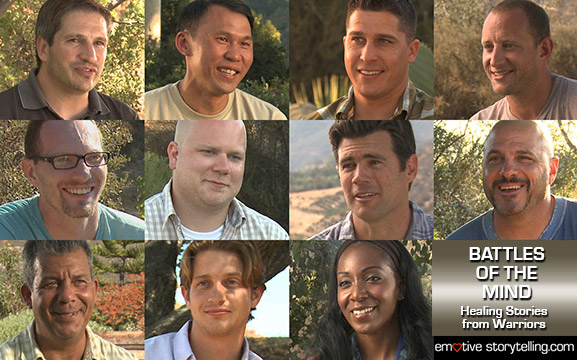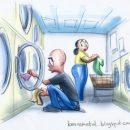Our team here at EmotiveStorytelling.com has just spent two days filming and recording the stories of eleven Veterans, most of whom have seen and survived the worst of combat in Iraq and Afghanistan. It was an extraordinary experience that deeply touched all of us who were involved. Each of these Vets has suffered lasting consequences of their combat experience, including Post-Traumatic Stress, mTBI and other emotional pain associated with combat or trauma.

Veterans share their stories of healing with us.
As we got to know each other and developed a bit of trust, an amazing transformation began to happen, right before our eyes. These hardened combat veterans gradually softened as they shared their experiences of combat and their struggles to recover a semblance of a normal life. Their stories gradually took shape in individual interviews, as they talked among themselves and later, as a group.
As these stories were told over and over, under different circumstances and to different listeners, our Veterans began to open up. The details of their stories became more striking while at the same time, the power of their stories to cause hurt and pain as they were told, lessened markedly. We watched as their countenance changed and their bodies relaxed. Details emerged that even intimate partners hadn’t been told.
The universal opinion of our group was that telling their stores to others who have “been there” was especially important. They knew there would be no judging or evaluation, just listening and understanding.

Veterans share healing stories by campfire
Despite the uncertainty that came with being filmed, each of these Vets offered themselves and their stories as a gift to others who are struggling. They submitted themselves to this process in order to let others know that there was hope, and to communicate that it was critically important that everyone who is struggling tell their story — that telling the story, no matter how painful, was the true path to healing.
The problem, of course, is that telling a traumatic story is painful and counter-intuitive to those who are suffering.
It seems to make more sense to try to push it away, to numb oneself with alcohol or drugs, and to distance from those who want to understand. The message these Vets have for all those who are struggling with trauma, is to tell their story, no matter how difficult, no matter how painful.
Our team will be making these stories available to service members and Veterans who need to hear this message from those who have seen it all and who have returned to tell their story. Stay tuned for the rest of the story.










No comments yet.